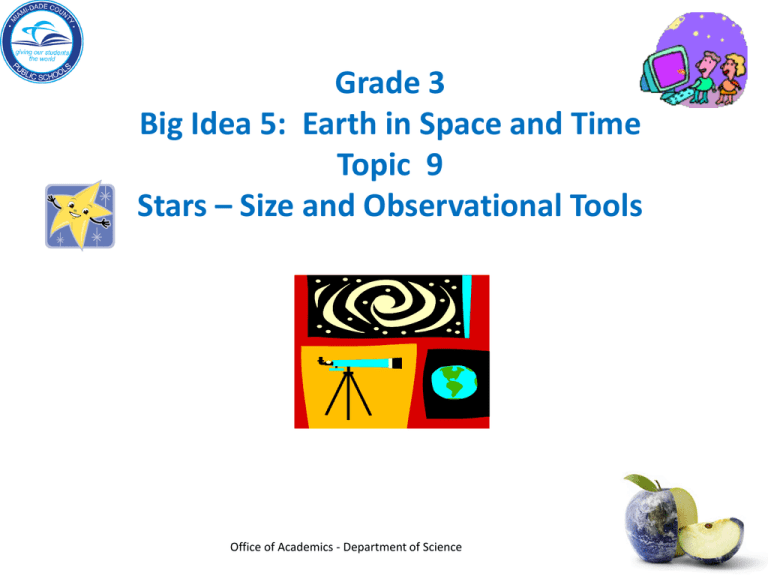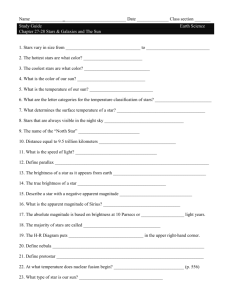SC.3.E.5.1 Stars
advertisement

Grade 3 Big Idea 5: Earth in Space and Time Topic 9 Stars – Size and Observational Tools Office of Academics - Department of Science Big Idea 5: Earth & Space Science • SC.3.E.5.1 Explain that stars can be different; some are smaller, some are larger, and some appear brighter than others; all except the Sun are so far away that they look like points of light. Cognitive Complexity: High • SC.3.E.5.5 Investigate that the number of stars that can be seen through telescopes is dramatically greater than those seen by the unaided eye. Cognitive Complexity: Moderate • SC.3.N.3.2 Recognize that scientists use models to help understand and explain how things work. • Cognitive Complexity: Low • SC.3.N.3.3 Recognize that all models are approximations of natural phenomena; as such, they do not perfectly account for all observations. • Cognitive Complexity: Moderate Office of Academics - Department of Science Watching the Night Sky What do you want to know about the night sky? What do we call scientists who study space? Astronomers What tools do astronomers use? Telescopes Office of Academics - Department of Science How Do Telescopes Help Scientists? • Telescopes make distant objects in space look much closer. • They use lenses and/or mirrors to magnify what is being observed. • Are all telescopes alike? Explain. Telescopes Office of Academics - Department of Science Lens Lab Materials needed: a clear plastic bottle, water, and paper with print Step 1: Fill the bottle with water, so there are no air bubbles. Put the cap on. Step 2: Write a prediction of what will happen when you put the bottle across the paper and look at the lines of type. Step 3: Count the number of spaces between lines on the paper that fit into one of the spaces between the lines you see through the bottle. How many times did your bottle magnifier magnify? Step 4: What happened? Did it support your prediction? Office of Academics - Department of Science Stars (Sung to Twinkle, Twinkle, Little Star) Twinkle, Twinkle, Little Star I know what you really are: Giant ball of glowing gas, One of millions in a mass! Twinkle, Twinkle, Little Star, Oh, how big you really are! Twinkle, Twinkle, Little Star Larger than the Earth by far! Since your distance is a lot, You look like a tiny dot. Twinkle, Twinkle, Little Star Very bright, yet very far! Stars are twinkling, every one, Some are bigger than the sun! Just a twinkle in the sky! Just because you’re oh, so high! Twinkle, Twinkle, Little Star, Oh, how big you really are! A Look at Some Constellations: Objects in the Sky Office of Academics - Department of Science Stars and the Universe What Are Stars? • • • • • • Every star is a huge ball of burning gas. Stars are very bright. Stars come in different sizes. Our Sun is our closet star. All the other stars we see are very far away. Stars are made mostly of hydrogen and helium gas. Office of Academics - Department of Science Why Do Big Stars Look So Tiny? Investigation Object Size (Diameter) of Object Distance when Objects Look the Same Size Small lid ______ centimeters wide _____meters _____ cm Sandwich Paper Plate ______ centimeters wide _____meters _____ cm Dinner Paper Plate ______ centimeters wide _____meters _____ cm Office of Academics - Department of Science Are these balls the same size? Office of Academics - Department of Science Why do they look the same size now? Office of Academics - Department of Science How are Stars different? • Stars come in all different sizes. • Our Sun is the standard used for comparing all other star sizes. • The biggest stars are called supergiants. Some are 500 times larger than the Sun. • Some of the smallest stars are white dwarfs. Many are 1/100 the size of the Sun roughly the size of Earth Office of Academics - Department of Science Sizing Up Stars Activity Essential Question: How big are some of the stars in the sky? Learning Goals: • Learn how scientists called astronomers measure star size. • Work together in groups to solve a logic puzzle that gives the sizes of seven stars. Office of Academics - Department of Science Sizing Up Stars Activity Directions 1. Students in each group must work as a team. 2. Group team members need to cut up their clue cards and cut apart the star names at the bottom of page 44. 3. Each team member takes one clue card and takes his/her turn reading their card to their group. If the clue gives information that be immediately used to identify a star’s size, then the answer is recorded. If not, continue with the reading of other clues. 4. Team members can read the clues as many times as necessary until the size if each star is known. 5. Groups share out their solutions to make sure everyone reached the same conclusions. Office of Academics - Department of Science Sizing Up Stars Data Star Name C Solar Radii 2 9 40 65 70 650 750 Office of Academics - Department of Science Sizing Up Stars Connected Learning 1. How do scientists measure star size? 2. What units is used to talk about star size? What does it mean? 3. Were any stars on our list smaller than the sun? How do you know? 4. How much bigger than the sun is the smallest star on our list? … the largest star on our list? How do you know? 5. What did you discover as you worked to solve the logic problem? Office of Academics - Department of Science What Did You Learn About the Sun and Stars? Review: A Closer Look at the Sun and Stars TAG Reflection: • Tell a fact you learned about the stars. • Ask a question about something you don’t understand about stars? • Give another idea that you learned in our study of the stars. Office of Academics - Department of Science








